The agricultural supply chain is the foundation of our economy. But it is plagued by inefficiencies. Blockchain technology could be the fix.
The food on your table may have traveled thousands of miles, across states and countries, before you purchased it. There are often hundreds of participants in this complicated supply chain. While this provides a great variety of consumer options, it also presents challenges.
Our agricultural supply chain is becoming increasingly overstretched. Its inefficiencies cost the economy around $400 billion each year. With rising challenges from the climate crisis, getting a grip on this problem is more important than ever before. Blockchain technology could help solve the problems plaguing our agricultural supply chain.
What does blockchain have to do with supply chains?
Most people associate blockchain with Bitcoin. But the technology itself is relevant to many industries. Blockchain technologies are distributed, cryptographic ledgers that can be accessed by anybody with the right keys. At the same time, they cannot be altered or changed by anyone.
So, blockchains provide secure, transparent stores of data that foster trust. Some describe blockchain’s value as a ‘single source of truth’ that has no middlemen. This has many applications in the food industry. Consider, for example, that 71% of consumers place a premium on traceability.
In combination with Internet of Things (IoT) technology and data analytics, blockchains can provide a shared protocol for every actor in the supply chain to log and share data at each stage of the commodity’s journey.
The process can be used to incentivize each participant to provide critical and accurate data, driving down costs of inefficiencies, boosting profits, and meeting government and consumer-driven sustainability and transparency goals.
Sustainable seafood example
To understand how this works let’s look at the hypothetical journey of a sustainably farmed salmon shipment. Each fish is given a tag with a QR code. This code contains all data about the origins of the salmon, including where it was farmed and how and when it was packed.
As the salmon moves through each stage of the supply chain, key parameters and transactions are recorded. It is possible for any actor in the supply chain to see the status of the salmon, including its temperature. More importantly, it is possible to see what has occurred at each stage, and who was involved.
Once the salmon hits retail shelves, the customer can use that same code to discover the origin of the fish and confirm that it has been sustainably fished. For more on this concept explore Fishcoin’s ecosystem.
This process has several implications. It makes it far easier to identify and eliminate bad actors in existing supply chains. It also makes it possible to quickly pinpoint contamination.
Finally, it gives consumers and food retail verified provenance and traceability. This can also help downstream players like hotels and restaurants satisfy consumer preferences while boosting their brands.

Examples of current projects
There are many similar blockchain projects underway. Here are some of the most interesting ones.
The Norwegian Seafood Association, Sjømatbedriftene, announced last summer that it is using IBM’s blockchain solutions to provide provenance and tracking information, to ensure food security and quality. Interestingly, Denmark’s BioMar, a provider of fish feed, has joined their network, adding another dimension to traceability.
One of the most interesting projects is Esri’s Geo Blockchain project, aimed at combating food spoilage. The company’s example combines IoT monitoring devices with geolocation data on a Geographical Information System (GIS) map.
The purpose of the project is to provide an immutable record of temperature at specific points in a product’s journey. This would empower a supply chain manager to identify exactly where problems in a supply chain are occurring, and implement steps to eliminate or mitigate the problem, improving the overall efficiency of the supply chain in question.
There are other projects aimed at providing more surety to customers. For example, the Malaysian Palm Oil Council (MPOC) is using blockchain to monitor sustainable palm oil production.
Palm oil is a vital product to the economy of Malaysia, but illicit operations have caused significant environmental damage. This has hurt consumer confidence. Blockchain will enable the organization to provide consumers with verifiable evidence that their palm oil has indeed been sustainably produced.
Blockchain technologies are just one piece of the puzzle
Blockchain technologies are just one part of solving the problem. To be effective, it must be married to other technologies, particularly GIS and IoT.
